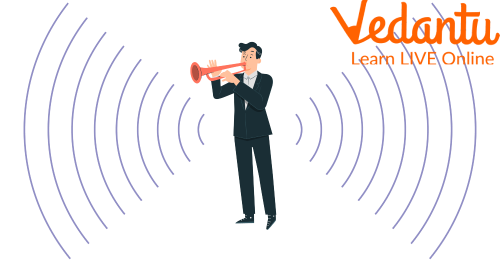




What Are Sound Waves and How Do They Work?
Let’s do a little exertion. Put your head on the table and make the knocking sound on the table or the down (strike) of the table. What did you hear? Did you observe the difference in sound when you knock on the table and when you knock strike?

Sound
Have you ever wondered what makes this difference and how sound expeditions from the table to your observance? No worries, you’ll learn all this. You’ll learn about sound energy which will be followed up by the medium that is demanded in travelling. Yeah, sound also needs a medium to travel and this can be air or water. How this medium affects the frequency of sound, it’ll be discussed also.
What are Sound Waves?
Definition of sound:- Sound is an energy form. Wobbling air, water, wood, or whatever substance the vibration/ mechanical stir is near is what sound energy is about. The climate produces sound, which is a kind of energy. When an object vibrates, it causes the motes in the air around it to move. These motes collide with near motes, forcing them to joggle as well.

Sound
Sound Wave
A sound wave (surge) is the pattern of a disturbance generated by the inflow of energy as it propagates down from the source of the sound across a medium (similar to air, water, or any other liquid or solid matter). A source is a vibration-producing object, similar to a ringing phone or a person's oral cords.

Sound wave
What are Sound Waves Created by?
Sound is made up of climate, or sound swells, that we can hear. These sound swells are formed by objects wobbling (shaking back and forth). Sound waves travel through the air, water, and solid objects as climate. When they reach our cognizance, these swells make the delicate skin of the eardrums joggle.
When an object vibrates, a pressure surge is created, which produces sound. The patches in the girding medium (air, water, or solid) joggle as a result of the pressure surge. The climate of the patches moves bordering patches, allowing the sound to travel deeper across the medium.
What Makes the Sound?
Sound vibration: Do you ever wonder how you manage to hear all of the varied sounds in your environment? You hear sounds every day as you talk to your family and friends, listen to music, go to the playground, and do a variety of other activities. All of these noises are heard because of sound vibrations, which are invisible waves that move swiftly up and down and are translated into sound by our brain.

What Makes the Sound?
All sounds are produced by vibrations, everything from clapping your hands to playing an instrument to knocking on a door.
What Vibrates to Make a Sound?
So, where does a sound begin? It all starts with a movement or event, similar to slighting your hands together snappily, plucking a guitar string, or slamming your fist against a door.
When anything like this happens, the object's motes, or the bitty units of matter that make it up, joggle. This causes other motes hard to joggle, and the climate travels through the motions until they reach your observance. The climate is latterly transmitted to your brain, which interprets them as sound.

Vibration
Now, the important question is what vibrates to make a sound. The air motes joggle as the sound moves through the air. In our voice box, oral cords joggle to produce the sound and the eardrum vibrates when the sound surge reaches it.
Three effects joggle when sound is created
the source object
the motes in the air (or another medium e.g. water)
the eardrum
Facts about Sound
Because there are no molecules to move through, sound cannot travel through space. We have air molecules vibrating in and around our ears here on Earth.
Do you know what is louder than a car horn? A human baby's cry is around 115 decibels.
Cows who listen to music produce significantly more milk than those who do not.
Summary
Sound is made up of climate, or sound swells, that we can hear. These sound swells are formed by objects wobbling (shaking back and forth). Sound swells travel through the air, water, and solid objects as climate. When they reach our cognizance, these swells make the delicate skin of the eardrums joggle. The air motes joggle as the sound moves through the air. In our voice box, oral cords joggle to produce the sound and the eardrum vibrates when the sound surge reaches it.
FAQs on How Is Sound Produced?
1. How is sound produced in simple terms?
Sound is produced when an object moves back and forth very quickly. This rapid movement is called a vibration. When something vibrates, it causes the air particles around it to vibrate as well. These vibrations travel through the air as waves, and when they reach our ears, our brain interprets them as sound.
2. What are some real-world examples of vibrations creating sound?
You can find many examples of sound production in your daily life. For instance:
When a school bell is struck, the metal vibrates, creating a loud ringing sound.
Plucking a guitar string makes it vibrate, which produces musical notes.
Your own voice is created when the vocal cords in your throat vibrate as air passes through them.
Clapping your hands causes the air between them to vibrate suddenly, making a sharp sound.
3. Can sound be produced without a medium like air, water, or solids?
No, sound cannot be produced or travel without a medium. A medium is any substance (like air, water, or a solid) that has particles to carry the vibrations. In a vacuum, like outer space, there are no particles to vibrate. That is why, no matter how large an explosion is in space, it would be completely silent.
4. How do our ears help us hear the sounds that are produced around us?
Our ears are designed to detect sound vibrations. When sound waves travel through the air and enter our ear canal, they hit the eardrum, causing it to vibrate. These vibrations are then passed through tiny bones in the middle ear to the inner ear, where they are converted into electrical signals. The brain receives these signals and interprets them as the sounds we recognise.
5. What is the difference between a loud sound and a soft sound?
The difference between a loud and a soft sound is determined by the strength or amplitude of the vibrations. Loud sounds are created by strong, large vibrations that carry more energy. For example, hitting a drum hard creates strong vibrations and a loud boom. Soft sounds are created by weak, small vibrations that carry less energy, like whispering or tapping a pencil lightly.
6. Why do different instruments, like a flute and a drum, make different kinds of sounds?
Different instruments produce different sounds because they vibrate in unique ways. The main difference is the speed of the vibrations, also known as frequency. A flute produces a high-pitched sound because the column of air inside it vibrates very quickly. A drum, on the other hand, produces a low-pitched sound because its large surface vibrates more slowly. The material, size, and shape of an object all affect how it vibrates and the specific sound it makes.
7. Does sound travel at the same speed through different materials?
No, sound does not travel at the same speed through all materials. It travels fastest through solids, slower through liquids, and slowest through gases like air. This is because the particles in a solid are packed very tightly together, allowing vibrations to pass from one particle to the next very quickly. In gases, the particles are far apart, so it takes longer for the vibrations to travel.









